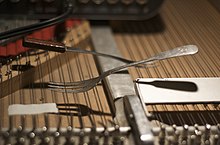

A prepared piano is a piano that has had its sounds temporarily altered by placing bolts, screws, mutes, rubber erasers, and/or other objects on or between the strings. Its invention is usually traced to John Cage's dance music for Bacchanale (1940), created for a performance in a Seattle venue that lacked sufficient space for a percussion ensemble. Cage has cited Henry Cowell as an inspiration for developing piano extended techniques, involving strings within a piano being manipulated instead of the keyboard. Typical of Cage's practice as summed up in the Sonatas and Interludes (1946–48) is that each key of the piano has its own characteristic timbre, and that the original pitch of the string will not necessarily be recognizable. Further variety is available with use of the una corda pedal.
Ferrante & Teicher between 1950 and 1980 used partially prepared pianos for some of their tunes in their albums. Other musicians, such as Denman Maroney use prepared piano for performances, whereas Cor Fuhler and Roger Miller have developed their own ways of using prepared piano in their musical albums. Additionally, notable contributors to the subsequent repertoire include Lou Harrison, Pauline Oliveros, James Tenney, and Christian Wolff.[1]
When a properly prepared piano has been "unprepared", it should be impossible for anyone to tell that it had ever been prepared.[2] Changes causing less easily reversible damage can be served by permanently dedicating an instrument, such as the tack piano. Other techniques related to prepared piano include the Acoustisizer.
- ^ Ripin, Edwin M., revised by Hugh Davies and Thomas J. Kernan (2013). "Prepared piano". In Sadie, Stanley; Tyrrell, John (eds.). The New Grove Dictionary of Music and Musicians (2nd ed.). London: Macmillan Publishers. ISBN 978-1-56159-239-5.
{{cite encyclopedia}}: CS1 maint: multiple names: authors list (link) - ^ Bunger, Richard (1973). The Well-Prepared Piano. Colorado Springs: Colorado College Music Press